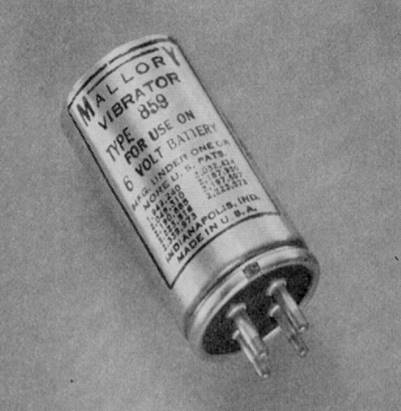The Vibrator Power Supply - Part One.
A Portable Source of Plate Voltage For Low/Medium-Power Applications
****====WARNING!====****
The vibrator discussed in these articles is also known as the electronic vibrator, which is meant for turning DC into a kind of AC. Another product going by the name "vibrator" is very prevalent on the internet. It also pertains to a market that has absolutely nothing to do with tube electronics. To stay on the safe side, don't perform any searches for electronic vibrator technology while using work computers or anything else where your web activity can be tracked and used against you. DON'T SAY I DIDN'T WARN YOU.It is a well-established fact that tubes require multiple voltage sources to operate. The original method for powering vacuum tube circuits was to use a set of batteries to generate plate and filament voltage, and occasionally grid bias voltage. Batteries worked well but placed a limit on the amount of power and complexity one could expect without incurring excess weight and bulk. A transformer connected to an alternating-current power grid was more versatile and reliable, and could be used indefinitely without needing a recharge or replacement. This worked so well that it was used in almost all vacuum tube equipment ever designed. However, the continuous access to the power grid only worked for most of the equipment, and a few niche applications needed a new solution.
Enter the vibrator.

Figure 1 A Typical Electronic Vibrator.
The vibrator allowed alternating current to be created from a storage battery, such as the main battery of a car or boat. These batteries received regular charges which mitigated the problem with earlier batteries, and also made available tube electronics where the power grid wasn't available. Such a solution allowed more power to be available in tube receivers and transmitters than was previously allowed by 90 volt plate batteries. They were designed for 6 volt operation to be compatible with automotive electrical systems of the day, but 12 volt vibrator supplies became available as cars adopted the higher-voltage systems.
The function of a vibrator is to chop a low battery voltage into an alternating current waveform so a transformer can produce a higher voltage for tube plates. This became standard for automobile radios and was used for receiving and transmitting equipment in aircraft and marine vessels as well. The power supply included a vibrator, transformer, rectifier, and filters, and was made to be mounted in the engine compartment or trunk. They were contained in metal boxes to limit the amount of radiated noise and increase the effectiveness of filtering. The vibrator power supply suited this application so well, it carried mobile electronics almost to the end of the vacuum tube age.
Before electronic vibrators, plate voltage could be created by use of a Dynamotor. This worked as an electric motor connected to a dynamo. These were heavier, larger, and less efficient but they were a way to create workable power when needed. A Dynamotor created a sine wave, where the vibrator created a square wave with a small amount of dead-time. The replacement of the Dynamotor made the proliferation of mobile tube radios not only possible but economical.
Editor's note.
More commonly used than the dynamotor was the motor generator set. These could be made to generate up to 750 volts DC at power levels of 200 watts or more. Because they generated Direct current they did not require a transformer and rectifier as did the dynamotor. This resulted in an increase of efficiency. However the vibrator remained the power supply of choice for relative low power devices such as AM broadcast receivers. Such car radios were never powered by a dynamotor or motor generator set. In all but a very few models the vibrator power supply was incorporated in the same enclosure as the rest of the radio.The electronic vibrator was a good solution to the mobile B+ problem, but it had a number of drawbacks. The main issue was that the mechanical part failed so often that it was made with a plug-in base for easy removal when the time came. The contacts would be damaged easily by over-currents or arcing, and required a special burnishing tool for resurfacing without damaging the plating. The reed itself could experience metal fatigue and lose its ability to make and break contact reliably. The electromagnetic coil could open. Nonetheless, the benefits of the vibrator made it a reasonable choice for electronics for more than thirty years.
The end of the vibrator supply was the end of the high-voltage car radio itself. Transistors were present in the mid-fifties, but were ill-suited for radio frequency. Vibrators were still in use for mobile transmitters where the high voltage was necessary, but the more practical goal was adaptation for low-voltage power altogether. Thus, in the final days of tube electronics, a special line of car radio tubes was developed to operate from a 12 volt plate supply, with a power transistor in the audio power stage to develop a couple of watts to a speaker.
[1] Fundamental Principles of Vibrator Power Supply Design
(1947). P. R. Mallory Co. Indianapolis, IN.